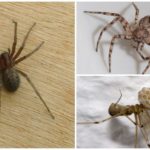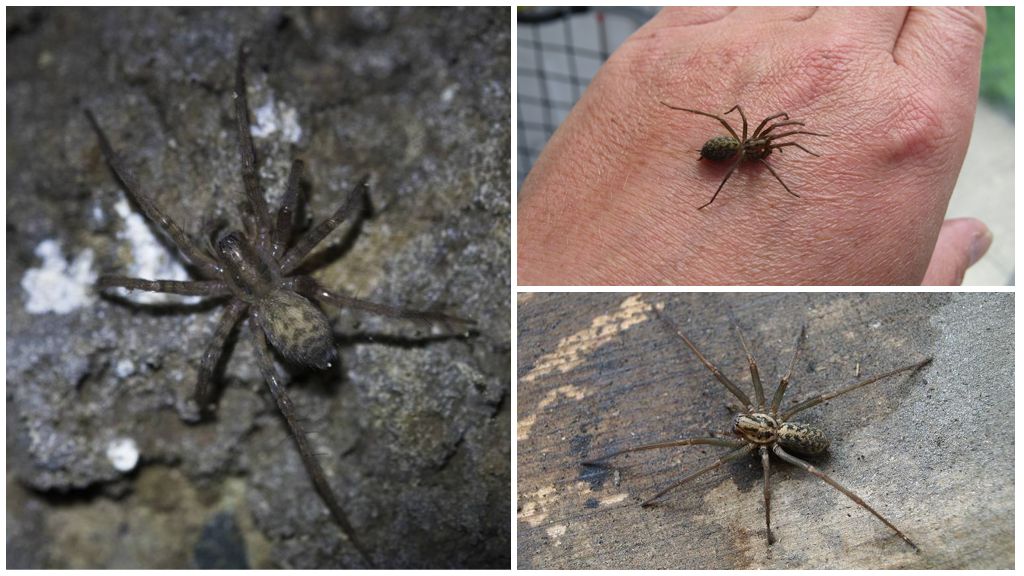House Spider (Tegenaria domestica)
- House Spider (Tegenaria domestica)
- House Spider (Tegenaria domestica)
The house spider or house spider, in Latin Tegenaria domestica, belongs to the huge family of funnel spiders. A close relative is the American tegenaria - Tegenaria agrestis. The size of the female is 12 mm, the male is 9 mm. Body color is yellow with a brown pattern. Distributed throughout the world. Lives in the wild, but often dwells in human dwellings, especially in attics. Not dangerous, does not attack, if you do not feel the danger.
Photos and appearance description
The house spider is widespread. In the warm season it lives in the forest, in the meadow, and also often settles in attics, in abandoned buildings, residential buildings, apartments. It penetrates inside through open windows, doors, cracks in the wall.
Appearance is well known to all. Body size with legs splayed no more than 12 mm, males are always smaller. The abdomen is oblong, connected with the cephalothorax with a thin web. Legs are long, powerful. On this body, legs drawing brown, red-brown color. A photo of a house spider is located below.
Interesting!
On the head there are 8 eyes, located in different parts of it - in front, on the sides, behind. The spider sees everything around him, but only silhouettes, shadows. Responds well to movement. On the paws are the organs of smell, touch - a link link with the appearance.
Habitat
In its natural environment, tegenaria brownie lives among plants and trees. You can find it under the bark, fallen leaves, snags, hollows, between the branches of trees, in the grass. Build a trap network near his refuge. The web resembles a funnel, hence the name of the species. However, it is preferable for him premises for different purposes.
The house spider settles in the corners, below, above, behind the furniture. Weaves a flat web of triangular shape. From it leaves the funnel, from the very center. In it sits the owner. Attic spider can braid everything around, starting from the corners, pumping beams, windows, walls.One web connects to another, long threads depart from it, along which the predator moves around the room.
Often settled house spider in the cellars, sheds, garages, premises for household purposes. Absolutely wherever he is not disturbed for a long time. The web is weaving at night, during the day the web traps are ready to catch potential victims. Threads sparkle in the sun, attracting the attention of insects.
Lifestyle
The house spider is sitting in a secluded place during the daytime, hiding away from the sun's rays, goes hunting at night. Uses trap networks or does without them. In the first case, the spider attacks on prey, which is accidentally entangled in the web. The predator injects poison, his own saliva. The first substance paralyzes the victim, the second dilutes the insides, which are then sucked out by the house spider. After some time, throws a funnel, forms a new one in another place.
The second method of hunting also involves the use of the web, but without the nets of snares. Spider stretches only 2 thin threads, he sits in a secluded place. As soon as the victim touches them, the predator immediately rushes to attack.The main diet consists of flies, fruit flies, mosquitoes, wasps, bees, as well as cockroaches, ants.
Interesting!
House spiders feel the change in atmospheric pressure very well. Before the rain they climb deeper into the burrow, they sit there, not protruding, before the sunny day weave traps of net all night.
Breeding
Tegenaria home leads a solitary lifestyle, going in pairs only during the mating period. The male finds the spider's web, neatly approaches, pulls the threads. The female, at the sight of a "boyfriend", either rushes to attack, or sits motionless in the center of the crater. The second option means that the lady is ready to accept a gentleman. After pairing, the pair remains together for some time. Then the most important thing for a male to retire in a timely manner, otherwise he will simply be eaten.
A few days later, the female begins to weave a cocoon of cobwebs, lays there eggs, hangs to the funnel, where she lives. Cubs develop about 20 days, all this time the tegenaria protects them. About 50 spiders are born. About 2 weeks are kept together, the mother feeds them, then crawl away in different directions.
Danger to humans
The poison of house spiders is toxic for small insects.Paralyzes almost instantly, death occurs within 10 minutes.
On a note!
Animals, people, predator does not attack. Tegenaria is calm, prefers to run away, hide, rather than attack. However, with a threat to your own life can bite. The situation occurs if a person accidentally crushes the house spider.
On the site of the bite remains a spot, swelling, slight swelling, irritation. The condition normalizes itself after a few days. There is no great harm from the poison of tegenaria. The arthropod is simply annoying with its presence, reminds that the general cleaning of the house has not been done for a long time. In a non-residential area, the size of the web is such that it covers the space from above, to the bottom.









